
Black-figure pottery painting, also known as the black-figure style or black-figure ceramic, is one of the styles of painting on antique Greek vases. It was especially common between the 7th and 5th centuries BCE, although there are specimens dating as late as the 2nd century BCE. Stylistically it can be distinguished from the preceding orientalizing period and the subsequent red-figure pottery style.
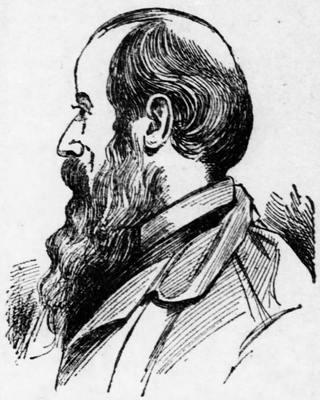
George Tinworth was an English ceramic artist who worked for the Doulton factory at Lambeth from 1867 until his death.

Sir Henry Doulton was an English businessman, inventor and manufacturer of pottery, instrumental in developing the firm of Royal Doulton.
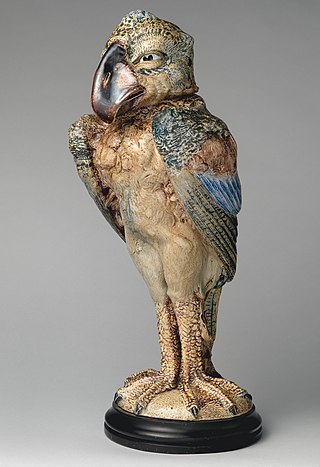
The four Martin Brothers were pottery manufacturers in London from 1873 to 1914. In their own day their Martinware was described as art pottery, and they were one of the earliest potteries making this, but in modern terms they fit better into the studio pottery category, which was invented later.

Wedgwood is an English fine china, porcelain and luxury accessories manufacturer that was founded on 1 May 1759 by the potter and entrepreneur Josiah Wedgwood and was first incorporated in 1895 as Josiah Wedgwood and Sons Ltd. It was rapidly successful and was soon one of the largest manufacturers of Staffordshire pottery, "a firm that has done more to spread the knowledge and enhance the reputation of British ceramic art than any other manufacturer", exporting across Europe as far as Russia, and to the Americas. It was especially successful at producing fine earthenware and stoneware that were accepted as equivalent in quality to porcelain but were considerably cheaper.
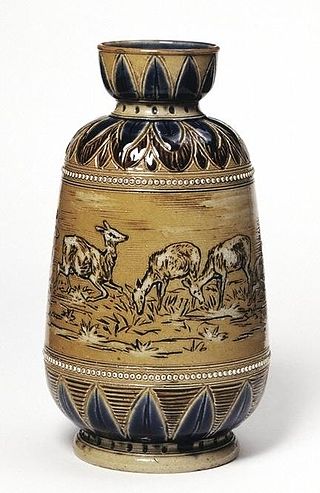
Royal Doulton is an English ceramic and home accessories manufacturer that was founded in 1815. Operating originally in Vauxhall, London, and later moving to Lambeth, in 1882 it opened a factory in Burslem, Stoke-on-Trent, in the centre of English pottery. From the start, the backbone of the business was a wide range of utilitarian wares, mostly stonewares, including storage jars, tankards and the like, and later extending to drain pipes, lavatories, water filters, electrical porcelain and other technical ceramics. From 1853 to 1901, its wares were marked Doulton & Co., then from 1901, when a royal warrant was given, Royal Doulton.

Mintons was a major company in Staffordshire pottery, "Europe's leading ceramic factory during the Victorian era", an independent business from 1793 to 1968. It was a leader in ceramic design, working in a number of different ceramic bodies, decorative techniques, and "a glorious pot-pourri of styles - Rococo shapes with Oriental motifs, Classical shapes with Medieval designs and Art Nouveau borders were among the many wonderful concoctions". As well as pottery vessels and sculptures, the firm was a leading manufacturer of tiles and other architectural ceramics, producing work for both the Houses of Parliament and United States Capitol.

Mary Gregory (1856–1908) was an American artist known for her decoration of glass products at the Boston and Sandwich Glass Company in Cape Cod, Massachusetts. Gregory worked for Boston and Sandwich from 1880 to 1884. Gregory painted lamps and plaques of landscape scenes during her years at B&SGC.

Agnete Hoy, also known as Anita Hoy, was an English artist potter who managed successfully to create a bridge between industrial ceramics and work of the studio potters. Having studied in Copenhagen she went on to work for the Holbæk and Saxbo potteries in the late-1930s before returning to England. Agnete's Danish experience helped her creativity within the English ceramic industry during the war years and the following period.
The Overbeck sisters were American women potters and artists of the Arts and Crafts Movement who established Overbeck Pottery in their Cambridge City, Indiana, home in 1911 with the goal of producing original, high-quality, hand-wrought ceramics as their primary source of income. The sisters are best known for their fanciful figurines, their skill in matte glazes, and their stylized designs of plants and animals in the Art Nouveau and Art Deco styles. The women owned and handled all aspects of their artistic enterprise until 1955, when the last of the sisters died and the pottery closed. As a result of their efforts, the Overbecks managed to become economically independent and earned a modest living from the sales of their art.

Kataro Shirayamadani, also known as Kitaro Shirayamadani was a Japanese ceramics painter who worked for Rookwood Pottery in Cincinnati, Ohio from 1887 until 1948.

Art pottery is a term for pottery with artistic aspirations, made in relatively small quantities, mostly between about 1870 and 1930. Typically, sets of the usual tableware items are excluded from the term; instead the objects produced are mostly decorative vessels such as vases, jugs, bowls and the like which are sold singly. The term originated in the later 19th century, and is usually used only for pottery produced from that period onwards. It tends to be used for ceramics produced in factory conditions, but in relatively small quantities, using skilled workers, with at the least close supervision by a designer or some sort of artistic director. Studio pottery is a step up, supposed to be produced in even smaller quantities, with the hands-on participation of an artist-potter, who often performs all or most of the production stages. But the use of both terms can be elastic. Ceramic art is often a much wider term, covering all pottery that comes within the scope of art history, but "ceramic artist" is often used for hands-on artist potters in studio pottery.
James Stiff was a noted English potter. He was born in 1808, the son of Robert Stiff, a workhouse master and farmer in Rougham, Suffolk. In 1831 he married Sarah Faulkner Philpott, and Lucy Potter in 1878.
Robert Stark Wilkinson (1843–1936) was a British architect. Born in Exeter, his father was a Town Councillor and Guardian. He studied architecture at the University of Oxford.
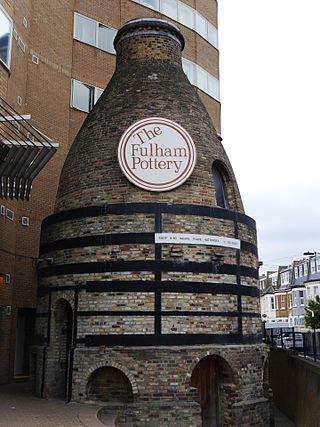
The Fulham Pottery was founded in Fulham, London, by John Dwight in 1672, at the junction of New King's Road and Burlington Road, Fulham, not far from Putney Bridge. Dwight is the earliest clearly documented maker of stoneware in England, although immigrant Dutch or German potters were probably active several decades before. By 1690 there was a rival stoneware operation in Fulham, run by the Dutch Elers brothers, who after a few years went off to become important early figures in transforming the Staffordshire pottery industry.
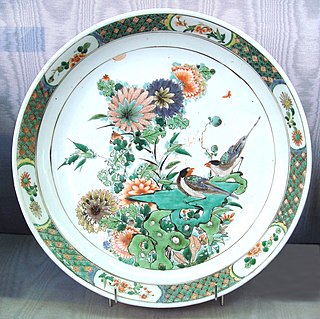
China painting, or porcelain painting, is the decoration of glazed porcelain objects such as plates, bowls, vases or statues. The body of the object may be hard-paste porcelain, developed in China in the 7th or 8th century, or soft-paste porcelain, developed in 18th-century Europe. The broader term ceramic painting includes painted decoration on lead-glazed earthenware such as creamware or tin-glazed pottery such as maiolica or faience.

American art pottery refers to aesthetically distinctive hand-made ceramics in earthenware and stoneware from the period 1870-1950s. Ranging from tall vases to tiles, the work features original designs, simplified shapes, and experimental glazes and painting techniques. Stylistically, most of this work is affiliated with the modernizing Arts and Crafts (1880-1910), Art Nouveau (1890–1910), or Art Deco (1920s) movements, and also European art pottery.

John Bennett (1840-1907) was a British ceramic artist who spent much of his career in America. He is known for decorative glazed earthenware with natural motifs.

John Eyre (1847-1927) was a British artist who decorated and designed British pottery. He also illustrated books and painted genre paintings. He is known for his paintings of Royal Hospital Chelsea and its veteran residents, as well as for paintings of working people in the pottery industry. He was a member of the Royal Society of British Artists, the Royal Institute of Painters in Watercolours (1917) and Honorary Associate of the Royal College of Art.

The pottery collection of the Albert Hall Museum in Jaipur, India, is a diverse 19th-century collection. The collection represents a wide range of crafts, techniques, and regions. The display includes unglazed vessels with ornamental decoration. The pottery techniques on display include burnished, lacquered, slip-painted, incised wares, and glazed pottery. The museum has representative pieces of Indian craftsmanship and other international pottery styles.























